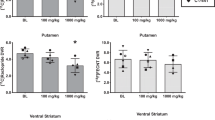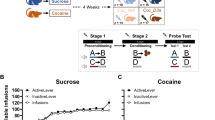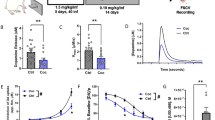Abstract
Although dopamine D3 receptors have been associated with cocaine abuse, little is known about the consequences of chronic cocaine on functional activity of D3 receptor-preferring compounds. This study examined the behavioral effects of D3 receptor-selective 4-phenylpiperazines with differing in vitro functional profiles in adult male rhesus monkeys with a history of cocaine self-administration and controls. In vitro assays found that PG 619 (N-(3-hydroxy-4-(4-(2-methoxyphenyl)piperazin-1-yl)butyl)-4-(pyridin-2-yl)benzamide HCl) was a potent D3 antagonist in the mitogenesis assay, but a fully efficacious agonist in the adenylyl cyclase assay, NGB 2904 (N-(4-(4-(2,3-dichlorophenyl)piperazin-1-yl)butyl)-9H-fluorene-2-carboxamide HCl) was a selective D3 antagonist, whereas CJB 090 (N-(4-(4-(2,3-dichlorophenyl)piperazin-1-yl)butyl)-4-(pyridin-2-yl)benzamide HCl) exhibited a partial agonist profile in both in vitro assays. In behavioral studies, the D3 preferential agonist quinpirole (0.03–1.0 mg/kg, i.v.) dose-dependently elicited yawns in both groups of monkeys. PG 619 and CJB 090 elicited yawns only in monkeys with an extensive history of cocaine, whereas NGB 2904 did not elicit yawns, but did antagonize quinpirole and PG 619-elicited yawning in cocaine-history monkeys. In another experiment, doses of PG 619 that elicited yawns did not alter response rates in monkeys self-administering cocaine (0.03–0.3 mg/kg per injection). Following saline extinction, cocaine (0.1 mg/kg) and quinpirole (0.1 mg/kg), but not PG 619 (0.1 mg/kg), reinstated cocaine-seeking behavior. When given before a cocaine prime, PG 619 decreased cocaine-elicited reinstatement. These findings suggest that (1) an incongruence between in vitro and in vivo assays, and (2) a history of cocaine self-administration can affect in vivo efficacy of D3 receptor-preferring compounds PG 619 and CJB 090, which appear to be dependent on the behavioral assay.
Similar content being viewed by others
Log in or create a free account to read this content
Gain free access to this article, as well as selected content from this journal and more on nature.com
or
References
Achat-Mendes C, Grundt P, Cao J, Platt DM, Newman AH, Spealman RD (2010). Dopamine D3 and D2 receptor mechanisms in the abuse-related behavioral effects of cocaine: studies with preferential antagonists in squirrel monkeys. J Pharmacol Exp Ther 334: 556–565.
Achat-Mendes C, Platt DM, Newman AH, Spealman RD (2009). The dopamine D3 receptor partial agonist CJB 090 inhibits the discriminative stimulus but not the reinforcing or priming effects of cocaine in squirrel monkeys. Psychopharmacology 206: 73–84.
Baladi MG, Newman AH, France CP (2010). Dopamine D3 receptors mediate the discriminative stimulus effects of quinpirole in free-feeding rats. J Pharmacol Exp Ther 332: 308–315.
Boeckler F, Gmeiner P (2006). The structural evolution of dopamine D3 receptor ligands: structure–activity relationships and selected neuropharmacological aspects. Pharmacol Ther 112: 281–333.
Caine SB, Koob GF (1993). Modulation of cocaine self-administration in the rat through D-3 dopamine receptors. Science 260: 1814–1816.
Caine SB, Negus SS, Mello NK (2000). Effects of dopamine D1-like and D2-like agonists on cocaine self-administration in rhesus monkeys: rapid assessment of cocaine dose–effect curves. Psychopharmacology 148: 41–51.
Carroll FI, Howell LL, Kuhar MJ (1999). Pharmacotherapies for treatment of cocaine abuse: preclinical aspects. J Med Chem 42: 2721–2736.
Cervo L, Carnovali F, Stark JA, Mennini T (2003). Cocaine-seeking behavior in response to drug-associated stimuli in rats: involvement of D3 and D2 dopamine receptors. Neuropsychopharmacology 28: 1150–1159.
Clarke WP (2005). What's for lunch at the conformational cafeteria? Mol Pharmacol 67: 1819–1821.
Code RA, Tang AH (1991). Yawning produced by dopamine agonists in rhesus monkeys. Eur J Pharmacol 201: 235–238.
Collins GT, Calinski DM, Newman AH, Grundt P, Woods JH (2008). Food restriction alters N′-propyl-4,5,6,7-tetrahydrobenzothiazole-2,6-diamine dihydrochloride (pramipexole)-induced yawning, hypothermia, and locomotor activity in rats: evidence for sensitization of dopamine D2 receptor-mediated effects. J Pharmacol Exp Ther 325: 691–697.
Collins GT, Newman AH, Grundt P, Rice KC, Husbands SM, Chauvignac C et al. (2007). Yawning and hypothermia in rats: effects of dopamine D3 and D2 agonists and antagonists. Psychopharmacology 193: 159–170.
Collins GT, Witkin JM, Newman AH, Svensson KA, Grundt P, Cao J et al. (2005). Dopamine agonist-induced yawning in rats: a dopamine D3 receptor-mediated behavior. J Pharmacol Exp Ther 314: 310–319.
Collins GT, Woods JH (2007). Drug and reinforcement history as determinants of the response-maintaining effects of quinpirole in the rat. J Pharmacol Exp Ther 323: 599–605.
Collins GT, Woods JH (2009). Influence of conditioned reinforcement on the response-maintaining effects of quinpirole in rats. Behav Pharmacol 20: 492–504.
Czoty PW, Gage HD, Nader SH, Reboussin BA, Bounds M, Nader MA (2007). PET imaging of dopamine D2 receptor and transporter availability during acquisition of cocaine self-administration in rhesus monkeys. J Addict Med 1: 33–39.
Di Chiara G, Imperato A (1988). Drugs abused by humans preferentially increase synaptic dopamine concentrations in the mesolimbic system of freely moving rats. Proc Natl Acad Sci USA 85: 5274–5278.
Gay EA, Urban JD, Nichols DE, Oxford GS, Mailman RB (2004). Functional selectivity of D2 receptor ligands in a Chinese hamster ovary hD2L cell line: evidence for induction of ligand-specific receptor states. Mol Pharmacol 66: 97–105.
Gehlert DR, Gackenheimer SL, Seeman P, Schaus J (1992). Autoradiographic localization of [3H]quinpirole binding to dopamine D2 and D3 receptors in rat brain. Eur J Pharmacol 211: 189–194.
Grundt P, Carlsson EE, Cao J, Bennett CJ, McElveen E, Taylor M et al. (2005). Novel heterocyclic trans olefin analogues of N-{4-[4-(2,3-dichlorophenyl)piperazin-1-yl]butyl} arylcaroxamides as selective probes with high affinity for the dopamine D3 receptor. J Med Chem 48: 839–884.
Grundt P, Prevatt KM, Cao J, Taylor M, Floresca CZ, Choi JK et al. (2007). Heterocyclic analogues of N-(4-(4-(2,3 dichlorophenyl)piperazin-1-yl)butyl)arylcarboxamides with functionalized linking chains as novel dopamine D3 receptor ligands: potential substance abuse therapeutic agents. J Med Chem 50: 4135–4146.
Hamilton LR, Czoty PW, Gage HD, Nader MA (2010). Characterization of the dopamine receptor system in adult rhesus monkeys exposed to cocaine throughout gestation. Psychopharmacology 210: 481–488.
Heidbreder CA, Newman AH (2010). Current perspectives on selective dopamine D3 receptor antagonists as pharmacotherapeutics for addictions and related disorders. Ann NY Acad Sci 1187: 4–34.
Karila L, Gorelick D, Weinstein A, Noble F, Benyamina A, Coscas S et al. (2008). New treatments for cocaine dependence: a focused review. Int J Neuropsychopharmacol. 11: 425–438.
Kebabian JW, Caine DB (1979). Multiple receptors for dopamine. Nature 277: 93–96.
Kenakin T (2002). Drug efficacy at G protein-coupled receptors. Ann Rev Pharmacol Toxicol 42: 349–379.
Le Foll B, Goldberg SR, Sokoloff P (2005). The dopamine D3 receptor and drug dependence: effects on reward or beyond? Neuropharmacology 49: 525–541.
Levant B, Grigoriadis DE, DeSouza EB (1992). Characterization of [3H]quinpirole binding to D2-like dopamine receptors in rat brain. J Pharmacol Exp Ther 262: 929–935.
Levant B (1997). The D3 dopamine receptor: neurobiology and potential clinical relevance. Pharmacol Rev 49: 231–252.
Martelle JL, Claytor R, Ross JT, Reboussin BA, Newman AH, Nader MA (2007). Effects of two novel D3-selective compounds, NGB 2904 and CJB 090, on the reinforcing and discriminative stimulus effects of cocaine in rhesus monkeys. J Pharmacol Exp Ther 321: 573–582.
Mello NK, Negus SS (1996). Preclinical evaluation of pharmacotherapies for treatment of cocaine and opiod abuse using drug self-administration procedures. Neuropsychopharmacology 14: 375–424.
Missale C, Nash SR, Robinson SW, Jaber M, Caron MG (1998). Dopamine receptors: from structure to function. Physiol Rev 78: 189–225.
Moore RJ, Vinsant SL, Nader MA, Porrino LJ, Friedman DP (1998). The effect of cocaine self-administration on dopamine D2 receptors in rhesus monkeys. Synapse 30: 88–96.
Nader MA, Daunais JB, Moore T, Nader SH, Moore RJ, Smith HR et al. (2002). Effects of cocaine self-administration on striatal dopamine systems in rhesus monkeys: initial and chronic exposure. Neuropsychopharmacology 27: 35–46.
Nader MA, Mach RH (1996). Self-administration of the dopamine D3 agonist 7-OH-DPAT in rhesus monkeys is modified by prior cocaine exposure. Psychopharmacology 125: 13–22.
Negus SS (2003). Rapid assessment of choice between cocaine and food in rhesus monkeys: effects of environmental manipulations and treatment with d-amphetamine and flupenthixol. Neuropsychopharmacology 28: 919–931.
Neisewander JL, Fuchs RS, Tran-Nguyen LT, Weber SM, Coffey GP, Joyce JN (2004). Increases in dopamine D3 receptor binding in rats receiving a cocaine challenge at various time points after cocaine self-administration: implications for cocaine-seeking behavior. Neuropsychopharmacology 29: 1479–1487.
Newman AH, Grundt P, Nader MA (2005). Dopamine D3 receptor partial agonists and antagonists as potential drug abuse therapeutic agents. J Med Chem 48: 3664–3679.
Pilla M, Perachon S, Sautel F, Garrido F, Mann A, Wermuth CG et al. (1999). Selective inhibition of cocaine-seeking behavior by a partial dopamine D3 receptor agonist. Nature 400: 371–375.
Pilon C, Levesque D, Dimitriadou V, Griffon N, Martres MP, Schwartz JC et al. (1994). Functional coupling of the human dopamine D3 receptor in a transfected NG 108-15 neuroblastoma–glioma hybrid cell line. Eur J Pharmacol 268: 129–139.
Ritz MC, Lamb RJ, Goldberg SR, Kuhar MJ (1987). Cocaine receptors on dopamine transporters are related to self-administration of cocaine. Science 237: 1219–1223.
Saloman Y, Londos C, Rodbell M (1974). A highly sensitive adenylate cyclase assay. Anal Biochem 58: 541–548.
Self DW, Barnhart WJ, Lehman DA, Nestler EJ (1996). Opposite modulation of cocaine-seeking behavior by D1- and D2-like dopamine receptor agonists. Science 271: 1586–1589.
Sokoloff P, Giros B, Martres M, Bouthenet M, Schwartz J (1990). Molecular cloning and characterization of a novel dopamine receptor (D3) as a target for neuroleptics. Nature 347: 146–151.
Staley JK, Mash DC (1996). Adaptive increase in D3 dopamine receptors in the brain reward circuits of human cocaine fatalities. J Neurosci 16: 6100–6106.
Substance Abuse and Mental Health Services Administration SAMHSA Office of Applied Studies (2008). Results from National Survey on Drug Use and Health.
Taylor M, Grundt P, Griffin SA, Newman AH, Luedtke RR (2010). Dopamine D3 receptor selective ligands with varying intrinsic efficacies at adenylyl cyclase inhibition and mitogenic signaling pathways. Synapse 64: 251–266.
Vocci JF, Acri J, Elkashef A (2005). Medication development for addictive disorders: the state of the science. Am J Psychiatry 162: 1432–1440.
Xi ZX, Gardner EL (2008). Hypothesis-driven medication discovery for the treatment of psychostimulant addiction. Curr Drug Abuse Rev 1: 303–327.
Xi ZX, Newman AH, Gilbert JG, Pak AC, Peng XQ, Ashby Jr CR et al. (2006). The novel dopamine D3 receptor antagonist NGB 2904 inhibits cocaine's rewarding effects and cocaine-induced reinstatement of drug-seeking behavior in rats. Neuropsychopharmacology 7: 1393–1405.
Zhang A, Neumeyer JL, Baldessarini RJ (2007). Recent progress in development of dopamine receptor subtype-selective agents: potential therapeutics for neurological and psychiatric disorders. Chem Rev 107: 274–302.
Acknowledgements
We thank Tonya Calhoun and Susan Nader for excellent technical assistance. This research was supported by the National Institute on Drug Abuse Grant R01 DA12460 (to MAN) and by the NIDA Intramural Research Program (to AHN).
Author information
Authors and Affiliations
Corresponding author
Ethics declarations
Competing interests
The authors declare no conflict of interest.
Rights and permissions
About this article
Cite this article
Blaylock, B., Gould, R., Banala, A. et al. Influence of Cocaine History on the Behavioral Effects of Dopamine D3 Receptor-Selective Compounds in Monkeys. Neuropsychopharmacol 36, 1104–1113 (2011). https://doi.org/10.1038/npp.2010.248
Received:
Revised:
Accepted:
Published:
Issue date:
DOI: https://doi.org/10.1038/npp.2010.248
Keywords
This article is cited by
-
Effects of buspirone and the dopamine D3 receptor compound PG619 on cocaine and methamphetamine self-administration in rhesus monkeys using a food-drug choice paradigm
Psychopharmacology (2015)
-
Dopamine D3 Receptor Function and Cocaine Exposure
Neuropsychopharmacology (2012)



